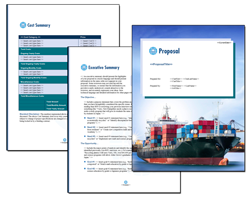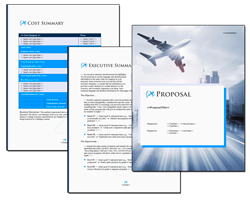
How to Write an Import/Export Business Proposal: Step-by-Step Guide
Are you looking to create an import/export business proposal that can attract clients and secure partnerships? This guide is suitable for those looking to start and operate their own import/export business as well as established companies pitching new clients or partnerships. This guide will walk you through each essential step of how to write an import/export business proposal, covering everything from understanding its purpose to finalizing a polished document.
There are many types of proposals, from business plans seeking funding, selling services to clients, internal company projects, and so on. All of these can be created using a Proposal Kit.
When developing your proposal, it's important to understand the differences between various business models, such as an export management company and an import/export merchant, as well as other models, such as an export trading company, which plays a key role in facilitating international trade transactions and strategic trading activities.
Key Takeaways
- An effective import/export business proposal outlines clear goals, capabilities, and a strategic vision to attract clients and partners.
- Key components include a strong executive summary, detailed business description, and a client-centered section that addresses specific client needs.
- Using Proposal Kit can streamline the proposal writing process and enhance quality, enabling businesses to create compelling documents efficiently.
Challenges Facing Import/Export Companies in the Global Economic Landscape

Import/export businesses today are grappling with considerable challenges stemming from the uncertain global economic climate and fluctuating tariff policies. Companies involved in international trade face complex decision-making scenarios as rapidly changing tariffs necessitate frequent supply chain reevaluations and rerouting. This ongoing uncertainty creates a volatile operating environment, impacting inventory management and causing many companies to delay or even halt orders temporarily.
The absence of consistent, predictable government policies further exacerbates these difficulties, making strategic long-term planning problematic for import/export businesses. Companies are increasingly forced to consider alternate sourcing and distribution points in countries offering more predictable trade conditions. This volatility demands exceptional flexibility and robust contingency planning within business proposals.
To successfully navigate these challenges, import/export proposals should highlight strategies such as diversified supply chain sources, real-time market intelligence systems, and strong contingency planning. Proposals must demonstrate preparedness for handling potential disruptions, underscoring adaptive capabilities and highlighting mitigation measures such as advanced logistics analytics and proactive risk management to reassure clients and stakeholders.
AI's Impact on Import/Export Companies: Short and Long-Term Perspectives
Artificial intelligence is significantly reshaping the import/export sector, presenting both short-term enhancements and long-term strategic transformations. In the immediate term, AI technologies provide substantial efficiency gains through predictive analytics, demand forecasting, and intelligent inventory management. These tools allow companies to better manage stock levels, optimize shipment routes, and quickly adapt to fluctuating market conditions, thereby minimizing costs and improving operational responsiveness.
In the longer term, AI is poised to revolutionize global trade logistics further through advanced automation, autonomous vehicles, and smart customs clearance processes. The adoption of AI-driven automation can significantly streamline regulatory compliance, reduce human error in complex documentation tasks, and accelerate border-crossing procedures, thus expediting international trade.
Companies must proactively integrate AI strategies into their business models. Proposals should clearly outline plans for adopting advanced AI technologies, addressing potential challenges such as workforce transitions, data security concerns, and necessary infrastructure investments. Demonstrating a clear strategy for leveraging AI innovations positions import/export businesses as forward-thinking leaders capable of navigating future market complexities effectively.
Understanding the Purpose of an Import/Export Business Proposal
An import/export business proposal is a cornerstone document for attracting clients and establishing partnerships in international trade. Beyond formality, it is a strategic tool that showcases your import/export business's vision, capabilities, and potential, making it indispensable for businesses aiming to carve out a niche in the global trade market as an export management company and an import/export merchant.
A well-articulated business plan significantly enhances your ability to secure funding by demonstrating clear business goals, market understanding, and a structured marketing plan. A comprehensive proposal is essential to raise funding from investors or banks, as it demonstrates the viability of your export-import venture and attracts the financial support needed for growth. This roadmap allows you to track your progress, ensuring every step aligns with your business planning objectives. It also showcases your readiness to navigate the complexities of the import/export process, from customs regulations to market demand analysis, all while adhering to an effective financial plan, business plan, operations plan, and export plan, including options for bank loans.
Building healthy relationships with distributors and participating in networking events can be significantly boosted by a robust business proposal. It serves as a testament to your business's professionalism and preparedness, making it easier to forge lasting partnerships crucial for long-term success.
Including supporting documents, such as legal paperwork, market research data, and financial statements, in your proposal further strengthens its credibility and comprehensiveness.
Key Components of an Import/Export Business Proposal

The backbone of a successful import/export business proposal lies in its key components. Understanding these elements is vital for creating a comprehensive and effective proposal that speaks directly to potential investors and partners. Typically, a business proposal includes:
- An introduction
- A client-centered section
- A detailed description of products and services
- A section dedicated to your company's credentials.
The introduction should include:
- A cover letter explaining who you are
- Why you're sending the proposal
- Your contact information
- A compelling call to action
This sets the stage for the reader, providing a clear, brief overview of your business intent and inviting further engagement.
A well-written business description should include:
- The company's legal structure, such as whether it operates as an LLC or sole proprietorship.
- Clear objectives and milestones to ensure a structured approach to measuring the success of your export business and its organizational structure.
- Details about your products and services, highlighting their unique features, pricing plans tailored to your target market's needs, and specifications of raw materials along with related services.
Proposals can also be tailored to address the needs of small businesses seeking to expand into international markets.
Writing an Executive Summary

The executive summary is one of the most critical parts of your import/export business plan. It provides a quick snapshot of your business and potential, engaging readers right from the start. This section functions as a powerful sales tool, articulating your business's vision and value proposition to attract investors and partners.
Your executive summary should encapsulate your business's name, location, product offerings, mission statement, and both short-term and long-term objectives. Additionally, it should identify key members and senior management, outlining their roles, responsibilities, and qualifications to establish credibility and demonstrate strong leadership. Writing it clearly and concisely highlights the unique aspects of your import/export business compellingly. The tone should be professional yet engaging, reflecting your business's character while appealing to potential stakeholders.
The goal of the executive summary is to pique interest and encourage further reading. It should provide enough information to understand your business's core without overwhelming the reader, making them eager to delve deeper into your proposal.
Detailed Business Description
A detailed business description is the heart of your import/export business proposal. It should include:
- A comprehensive overview of your company
- The company name
- The business concept
- Ownership structure
- Company History
- Future goals
- Whether it focuses on importing or exporting
Providing a clear idea of your business helps potential investors, other businesses, and partners understand your vision and operational framework. Outlining your supply chain is also essential, as it demonstrates operational readiness and your approach to risk management.
Your products and services should be clearly detailed, including features and pricing plans tailored to your target audience. Understanding the current demand for foreign goods is crucial as it helps identify feasible target markets for your products, ensuring you meet market needs effectively in more countries. Highlighting competitive advantages such as product quality, ethical sourcing practices, or a strong advertising plan can set your business apart from direct competitors in a new market.
For example, partnerships or funding programs can support new export opportunities, especially for agricultural products, by helping new farms overcome higher costs and access markets such as tourist destinations.
The revenue generation model should be transparent, explaining how your company will make money. Whether through direct sales, subscription models, or other means, this financial data is vital for demonstrating financial projections and financial forecasts to potential investors and maintaining a healthy balance sheet, as well as providing clear financial statements.
Conducting Market Research

Market research is the backbone of any successful import/export business plan. It provides valuable insights into opportunities, challenges, and industry analysis trends, helping you make informed decisions. Conducting market research and market analysis demonstrates your market knowledge and ability to claim market share, enhancing your proposal's credibility and attractiveness to investors.
There are two main methods of market research: primary and secondary. Primary research involves gathering information directly from potential buyers and markets, offering firsthand insights into market conditions and customer preferences. Secondary research provides cost-efficient data from existing sources, helping you assess market conditions without extensive fieldwork.
Key considerations for business strategy include:
- Analyzing market conditions
- Understanding target market demands
- Considering legal considerations
- Understanding the competitive landscape and identifying key competitors to position your business strategically, including conducting a competitive analysis
- Demonstrating an understanding of market trends relevant to clients' industries to strengthen your proposal and showcase your expertise and foresight.
- Reviewing an income statement is also essential, as it helps assess profitability and supports informed market entry decisions.
Competitive Analysis
A thorough competitive analysis is a cornerstone of any effective import/export business plan or proposal. By systematically evaluating the competitive landscape, you gain valuable insights into the strengths and weaknesses of both direct and indirect competitors operating in your target markets. This process begins with identifying key players in the import/export industry, including established companies, local businesses, and potential new entrants who may disrupt the market.
To conduct a robust competitive analysis, review your competitors' product offerings, pricing strategies, and marketing tactics. Pay close attention to how they position themselves at trade shows, their advertising campaigns, and their presence on social media platforms. Understanding customer preferences and current market trends will help you anticipate shifts in demand and adapt your own business strategy accordingly.
It's also important to monitor competitor activity on an ongoing basis, as market conditions and strategies can change rapidly in the global trade environment. By staying informed, your import/export business can refine its unique value proposition, differentiate itself from other businesses, and maintain a competitive edge. Ultimately, a well-executed competitive analysis not only informs your business plan but also empowers your export business to make strategic decisions that drive long-term success.
Client-Centered Section
The client-centered section of your import/export business proposal shows that you understand your potential client's business, needs, and concerns. This section differentiates your proposal from a generic sales brochure by demonstrating a deep understanding of the client's unique requirements. Customizing your proposal to align with specific client expectations can significantly enhance its effectiveness.
Effective communication with clients helps uncover their unique requirements and preferences, facilitating tailored solutions. Utilizing feedback from previous clients can guide the customization of future proposals, improving their relevance and effectiveness. Incorporating personalized elements, such as addressing specific client challenges, enhances engagement and shows attentiveness.
The clarity in this section can significantly enhance its effectiveness. A well-organized and easy-to-understand proposal is more likely to resonate with potential clients, making them feel understood and valued, fostering a clear understanding.
Describing Your Services and Costs

In the services description section of your import/export business proposal, explain how your proposed services meet the client's needs. This section should include a Services Provided page and a Cost Summary page. Offering a detailed breakdown of product types, specifications, and unique features helps potential clients understand the value of your offerings.
Value-added services such as logistics management and quality assurance can enhance the appeal of your business offerings and provide a competitive advantage. Transparent pricing strategy that reflects the quality and value of the services provided, including shipping costs, can build trust with potential clients. Clear articulation of service benefits helps align your offerings with client needs and expectations, making your proposal more compelling.
This section outlines what you offer and demonstrates how you add value to the client's business, making it an essential part of a winning business plan.
Export Business Strategy
Developing a comprehensive export business strategy is essential for any import/export business plan aiming to succeed in international markets. This strategy should start with a clear definition of your target market, including detailed demographic profiles, customer needs, and buying preferences. Understanding your target markets enables you to tailor your offerings and approach for maximum impact.
A strong export business strategy also includes a well-thought-out pricing strategy that considers production costs, competitor pricing, and prevailing market conditions. This ensures your products or services remain attractive and competitive across international borders. Your marketing plan should outline the specific tactics you'll use to promote your offerings - whether through digital marketing, trade shows, or partnerships with local distributors.
Logistics planning is another critical element, covering everything from shipping procedures and customs clearance to final delivery. Addressing these operational details in your business plan helps prevent costly delays and ensures a smooth import/export process. Additionally, your strategy should include risk management measures to address challenges such as currency fluctuations, trade barriers, and cultural differences.
Flexibility is key; as market conditions evolve, your export business strategy should be adaptable, allowing you to respond quickly to new opportunities or challenges. By integrating these elements, your import/export business can build a strong foundation for growth and repeat business in global markets.
Highlighting Company Credentials
Highlighting your company credentials is crucial. The all-about-you section should include your company history and experience to persuade potential clients of your capabilities. Presenting certifications and awards can significantly enhance your credibility and trustworthiness.
Accolades, even if not widely recognized, can reflect positively on your company's dedication and customer satisfaction. Incorporating feedback from peers can improve the overall quality and professionalism of the proposal, making it more appealing to potential clients and addressing potential risks and potential challenges.
This section showcases your company's strengths and achievements, builds trust, and positions your business as a reliable partner in the import/export industry.
Financial Plan

A solid financial plan is a vital part of any import/export business plan, providing a roadmap for the financial health and sustainability of your business. Start by presenting a detailed breakdown of your startup costs, including expenses for inventory, necessary licenses, marketing, and any other initial investments required to launch your company.
Next, develop realistic financial projections, including revenue forecasts that estimate sales and income over a specific period. A comprehensive cash flow forecast is equally important, as it outlines expected cash inflows and outflows, helping you anticipate and manage periods of tight liquidity. These financial statements should be based on sound assumptions, taking into account current market conditions, competition, and regulatory requirements.
Your financial plan should also detail your funding strategy, specifying sources such as personal savings, bank loans, or investments, along with the terms and conditions of any external financing. Addressing potential financial risks - like currency fluctuations or unexpected trade barriers - demonstrates to potential investors and stakeholders that you have a proactive approach to risk management.
By including these key components in your financial plan, your import/export business will be better positioned to secure funding, manage resources effectively, and achieve its business goals in the competitive world of international trade.
Using Proposal Kit
Using Proposal Kit tools can significantly streamline the proposal writing process. Proposal Kit provides:
- Content
- Legal contracts
- Design themes
- Thousands of templates to help produce proposals, reports, and other business documents efficiently
The AI Writer can quickly transform basic input into a polished proposal, making drafting a comprehensive document much more manageable.
The AI Writer is integrated seamlessly with the Proposal Pack Wizard, allowing users to generate formatted documents directly in Microsoft Word. Users can fine-tune the AI Writer's output by selecting preferences for tone, industry, and writing style, ensuring the content aligns with their brand. This structured workflow simplifies content creation, benefiting both novice and experienced writers.
The Proposal Kit also includes line item quoting tools, enabling automated generation of detailed financial pages, which enhance the overall proposal quality. This cost-efficient system operates on a credit-based model, allowing users to pay for AI-generated content only when needed.
Here are some related samples included in every downloadable Proposal Pack
The AI Writer generates a first draft of these templates - customized to your company, client, and project - in just minutes, giving you a head start on editing. Get any Proposal Pack or Proposal Kit Professional, and all of these samples, and the AI Writer are included.
Here are some related downloadable templates
The AI Writer generates a first draft of these templates - customized to your company, client, and project - in just minutes, giving you a head start on editing. Get any Proposal Pack or Proposal Kit Professional, and all of these templates and the AI Writer are included.
Proofreading and Finalizing Your Proposal
Proofreading and finalizing your proposal is essential to ensure it is error-free and maintains a professional appearance. Using checklists can streamline this process and help avoid overlooking important details. Reading the proposal out loud can help identify awkward phrases and improve the overall flow.
After completing the proposal, proofread every page and ensure it looks professional before delivering it. Following up with a phone call if you don't hear back can be an effective way to ensure your proposal has been received and reviewed.
This final step is crucial for making a strong impression, demonstrating your attention to detail, and reinforcing your commitment to professionalism.
Summary
In summary, creating a winning import/export business proposal involves understanding its purpose, incorporating key components, and highlighting your business's strengths. From conducting thorough market research to tailoring your proposal to client needs and using Proposal Kit tools, each step is designed to enhance your proposal's effectiveness. By following these guidelines, you can create a compelling and actionable business plan that sets the stage for your international trade success.
 Proposal Kit Professional provides the most content, including legal contracts and a free design theme pack. Plus, advanced software features include custom branding and customizable quoting databases.
Proposal Kit Professional provides the most content, including legal contracts and a free design theme pack. Plus, advanced software features include custom branding and customizable quoting databases. Proposal Pack for Any Business covers this type of proposal and includes samples. There are also some commonly used specialty design themes available:
Proposal Pack for Any Business covers this type of proposal and includes samples. There are also some commonly used specialty design themes available:Photo Design Proposal Packs
Frequently Asked Questions
What is the purpose of an import/export business proposal?
An import/export business proposal is vital for attracting clients and partnerships while also securing funding and clearly outlining your business goals. By presenting a solid proposal, you enhance your chances of success in the global market.
What are the key components of an import/export business proposal?
To create a successful import/export business proposal, focus on including an engaging introduction, a client-centered approach, a detailed description of your products and services, and highlighting your company's credentials. These elements will effectively showcase your value and attract potential clients.
How can Proposal Kit assist in writing proposals?
Proposal Kit can significantly streamline your proposal writing by offering a wide range of templates, content, legal contracts, design themes, and automation software, making the process efficient and easy. With these resources at your fingertips, you can create professional proposals that impress.
Why is market research important in an import/export business plan?
Market research is crucial in an import/export business plan as it uncovers valuable insights into opportunities and challenges, ensuring you make informed decisions and showcase your market knowledge. Embracing this knowledge sets you up for success in your venture.
What should be included in the services description section of a proposal?
Include a clear explanation of how your services meet the client's needs, along with a Services Provided page and a Cost Summary page for transparency. This will ensure your proposal stands out and resonates with your client.



 Cart
Cart
 Are you just looking for a template, sample, or software for your import/export proposals? Click these links to skip down the page and get right to it.
Are you just looking for a template, sample, or software for your import/export proposals? Click these links to skip down the page and get right to it.
















 Facebook
Facebook YouTube
YouTube Bluesky
Bluesky Search Site
Search Site